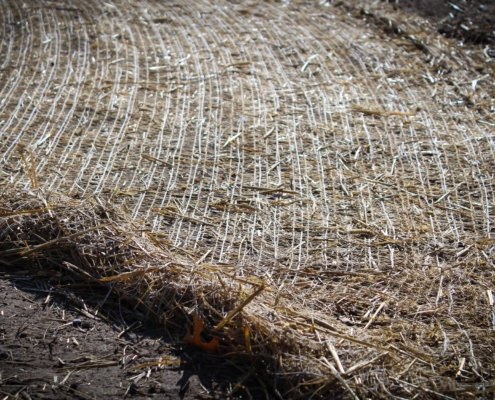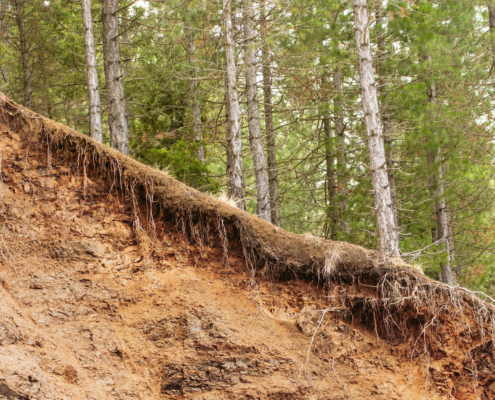 https://varsityinc.net/wp-content/uploads/2025/05/Erosion-Control-Net-Blanket.jpg
1250
2000
AbstraktMarketing
/wp-content/uploads/2020/02/Varsity_WebLogo-300x85.png
AbstraktMarketing2025-05-30 15:32:142025-08-26 16:42:25Signs Your Property Needs Immediate Commercial Erosion Control
https://varsityinc.net/wp-content/uploads/2025/05/Erosion-Control-Net-Blanket.jpg
1250
2000
AbstraktMarketing
/wp-content/uploads/2020/02/Varsity_WebLogo-300x85.png
AbstraktMarketing2025-05-30 15:32:142025-08-26 16:42:25Signs Your Property Needs Immediate Commercial Erosion ControlErosion Control Considerations: What Is Soil Infiltration Rate?
Why Soil Infiltration Matters
Soil infiltration plays a crucial role in various aspects of our environment, particularly in landscaping and the hydrologic cycle. By understanding soil infiltration, you can make informed decisions about drainage. This article will delve into the basics of soil infiltration, the factors affecting it, its role in the hydrologic cycle and agriculture, and its effects on plant growth.
What Is Soil Infiltration?
Soil infiltration is the process where water on the ground surface enters the soil. It’s a crucial factor in water cycle management, irrigation planning, and environmental sustainability. Soil infiltration is governed by two types of soil characteristics: physical and compositional.
The Basics of Soil Infiltration
Soil infiltration is a key process in the soil-water-plant-atmosphere continuum. By better understanding soil infiltration, you can more effectively manage landscaping activity and plan sustainable water management systems.
Factors Affecting Soil Infiltration
Various factors affect soil infiltration. These include the soil’s texture and structure as well as the amount of organic matter it contains. Clay-based soils with small pores have naturally low soil infiltration rates. On the other hand, the presence of organic matter and larger pore spaces in sandy or loamy soil can enhance infiltration rates.
How to Calculate Infiltration Rate in Soil
The soil infiltration rate is determined by measuring the rate at which water enters the soil. There are several methods to calculate soil infiltration rate:
1. Double Ring Infiltrometer Method
With this method, two concentric metal rings are inserted into the soil. The inner ring is filled with water, and the outer ring is used to prevent sideways movement of the water. The water level in the inner ring is measured at regular time intervals, and the infiltration rate is calculated by dividing the change in water level by the time.
2. Single Ring Infiltrometer Method
This is similar to the double ring method, but only one ring is used. Water is poured into the ring, and the infiltration rate is calculated by measuring the change in water level over time.
3. Constant Head Permeability Test
This method is commonly used for coarser soils. A constant water head is maintained above the soil sample in a permeameter. The flow rate of water through the soil sample is measured, and the infiltration rate is calculated by dividing the flow rate by the area of the sample.
4. Falling Head Permeability Test
This method is suitable for finer soils that have a slower infiltration rate. Water is allowed to infiltrate through a saturated soil sample, and the falling water head is measured at regular intervals. The infiltration rate is calculated using Darcy’s law, which relates the flow rate to the head difference.
It’s important to note that the soil infiltration rate can vary depending on factors such as soil type, compaction, and vegetation cover. Therefore, multiple measurements should be taken at different locations and averaged to get an accurate estimate of the infiltration rate.
Need help managing soil infiltration rates at your property? Connect with Varsity today.
The Role of Soil Infiltration
Understanding the role of soil infiltration in different contexts yields insight into its diverse effects and the ways soil management can affect these outcomes.
Soil Infiltration in the Hydrologic Cycle
Soil infiltration plays a substantial role in the hydrologic or water cycle. When rain falls, infiltration processes regulate the amount of water that seeps into the ground versus how much becomes runoff. Proper water infiltration helps replenish groundwater levels and reduces the risk of surface runoff leading to erosion or flooding.
Soil Infiltration in Landscaping
From a landscaping standpoint, soil infiltration is critical because it determines how much water is available for plants. Understanding the infiltration rate allows for more accurate irrigation planning, leading to better design and more efficient water use.
Effects of Soil Infiltration on Plant Growth
Plants with deep root systems thrive in soils with high infiltration rates. Conversely, plants that prefer wetter conditions may struggle in such soils. Thus, understanding a region’s soil infiltration rates can help in selecting the most suitable crops or plants to cultivate.
Impact and Manipulation of Soil Infiltration
The properties of soil infiltration can also be manipulated for better or worse through actions like land use change, landscaping practices, and more.
Soil Infiltration and Environmental Concerns
Environmental concerns related to soil infiltration usually focus on the potential for water pollution. When runoff is high due to poor soil infiltration, there is an increased risk of water bodies becoming contaminated with pollutants.
Techniques to Improve Soil Infiltration
Improving soil infiltration involves various techniques like soil aeration, adding organic matter and mulch, and maintaining soil cover, which can enhance the soil’s capacity to absorb water.
Application of Soil Infiltration in Modern Landscaping
Managing soil infiltration in landscaping is important to minimize runoff and irrigation needs, contributing to more sustainable and efficient water use.
Soil Infiltration and Climate Change: Emerging Trends
There is growing interest in understanding how the anticipated changes in rainfall patterns with climate change could alter soil infiltration and thus all of the processes that depend on it.
Tips for Managing Soil Infiltration
When it comes to commercial property landscaping, soil infiltration and erosion control are two of the most important aspects to consider. If left unchecked, runoff can cause serious damage to your property and increase maintenance costs. Fortunately, by following a few landscaping best practices, you can effectively manage soil infiltration rates and keep erosion at bay. Here are the steps you should take to manage soil infiltration and erosion on your commercial property:
Identify Runoff
The first step in managing soil infiltration and erosion is to identify the areas on your property that are prone to runoff. This includes slopes, low-lying areas, and other places where water accumulates. Once you’ve identified these areas, you can implement landscaping drainage techniques to reduce runoff and manage soil infiltration rates.
Install or Clean Downspouts
A popular technique for reducing runoff is using roof downspouts. This involves capturing the water from your roof and directing it away from your property through a series of pipes or channels. This ensures that the water does not accumulate in low-lying areas or flow downhill onto your property. Additionally, you should consider installing vegetation in vulnerable areas such as slopes or ditches. This will help retain moisture in the soil and slow down runoff.
Check for Proper Grading
Another important aspect of managing soil infiltration and erosion is maintaining proper grading on your property. This is especially true for commercial properties with large open spaces, as they’re more prone to flooding due to excess runoff. It’s important to have a graded slope away from any structures on your property, which will allow water to flow away from buildings rather than accumulating around them. If necessary, you can also install retaining walls to create an even grade across large open spaces and prevent flooding during heavy rains.
Look for Signs of Erosion
Finally, it’s important that you regularly check for signs of erosion on your property, such as bare patches of land or exposed tree roots. If you notice these signs, you may need to take additional steps to protect against further erosion, such as adding mulch or planting ground cover plants in affected areas. Be sure to also inspect drainage systems regularly for blockages or debris buildup, which could cause flooding if unchecked.
Choose Varsity to Manage Soil Infiltration and Ensure Proper Drainage
By following these landscaping best practices, you can effectively manage soil infiltration rates while keeping erosion under control. It may also be beneficial to consult with a landscape contractor who can provide advice on how best to maintain proper drainage and protect against runoff damage. With the right strategies in place, you can prevent runoff from becoming a serious issue for your commercial landscape while still enjoying its curb appeal!
Related Postings
 https://varsityinc.net/wp-content/uploads/2025/05/Erosion-Control-Net-Blanket.jpg
1250
2000
AbstraktMarketing
/wp-content/uploads/2020/02/Varsity_WebLogo-300x85.png
AbstraktMarketing2025-05-30 15:32:142025-08-26 16:42:25Signs Your Property Needs Immediate Commercial Erosion Control
https://varsityinc.net/wp-content/uploads/2025/05/Erosion-Control-Net-Blanket.jpg
1250
2000
AbstraktMarketing
/wp-content/uploads/2020/02/Varsity_WebLogo-300x85.png
AbstraktMarketing2025-05-30 15:32:142025-08-26 16:42:25Signs Your Property Needs Immediate Commercial Erosion Control https://varsityinc.net/wp-content/uploads/2024/07/Preventing-Soil-Erosion-Erosion-Control-for-Steep-Slopes.jpg
1250
2000
AbstraktMarketing
/wp-content/uploads/2020/02/Varsity_WebLogo-300x85.png
AbstraktMarketing2024-07-24 16:55:482025-08-26 16:42:26Preventing Soil Erosion: Erosion Control for Steep Slopes
https://varsityinc.net/wp-content/uploads/2024/07/Preventing-Soil-Erosion-Erosion-Control-for-Steep-Slopes.jpg
1250
2000
AbstraktMarketing
/wp-content/uploads/2020/02/Varsity_WebLogo-300x85.png
AbstraktMarketing2024-07-24 16:55:482025-08-26 16:42:26Preventing Soil Erosion: Erosion Control for Steep Slopes https://varsityinc.net/wp-content/uploads/2024/03/Underside-view-of-Chicago-City-Train-Bridge.jpg
1250
2000
AbstraktMarketing
/wp-content/uploads/2020/02/Varsity_WebLogo-300x85.png
AbstraktMarketing2024-03-11 13:45:422025-08-26 16:42:27Understanding Erosion Control Challenges in Urban Environments
https://varsityinc.net/wp-content/uploads/2024/03/Underside-view-of-Chicago-City-Train-Bridge.jpg
1250
2000
AbstraktMarketing
/wp-content/uploads/2020/02/Varsity_WebLogo-300x85.png
AbstraktMarketing2024-03-11 13:45:422025-08-26 16:42:27Understanding Erosion Control Challenges in Urban Environments


